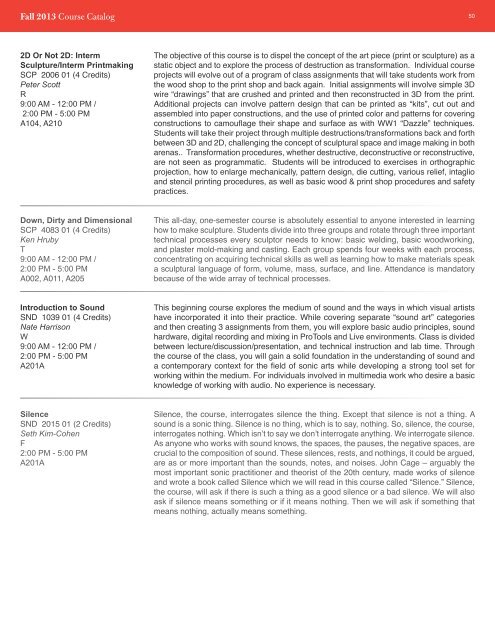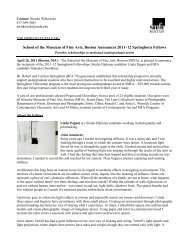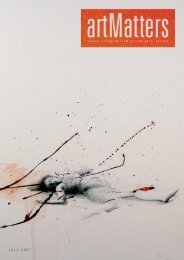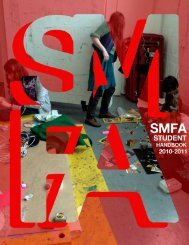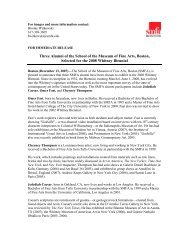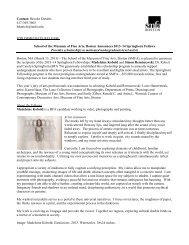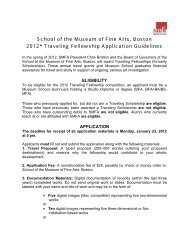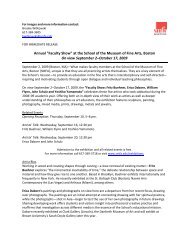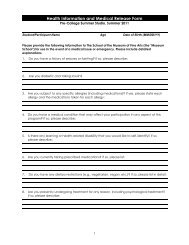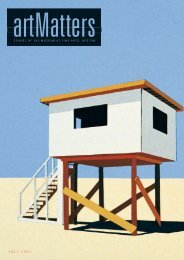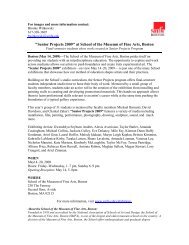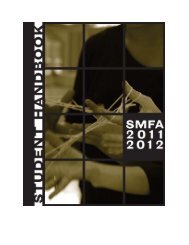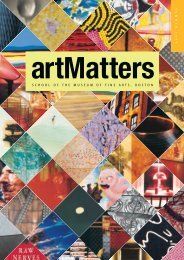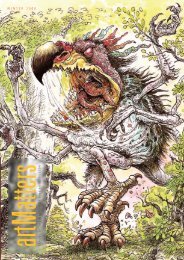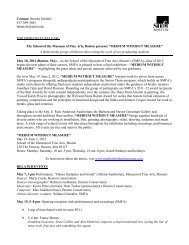Fall 2013 Course Catalog - School of the Museum of Fine Arts
Fall 2013 Course Catalog - School of the Museum of Fine Arts
Fall 2013 Course Catalog - School of the Museum of Fine Arts
Create successful ePaper yourself
Turn your PDF publications into a flip-book with our unique Google optimized e-Paper software.
<strong>Fall</strong> <strong>2013</strong> <strong>Course</strong> <strong>Catalog</strong><br />
50<br />
2D Or Not 2D: Interm<br />
Sculpture/Interm Printmaking<br />
SCP 2006 01 (4 Credits)<br />
Peter Scott<br />
R<br />
9:00 AM - 12:00 PM /<br />
2:00 PM - 5:00 PM<br />
A104, A210<br />
The objective <strong>of</strong> this course is to dispel <strong>the</strong> concept <strong>of</strong> <strong>the</strong> art piece (print or sculpture) as a<br />
static object and to explore <strong>the</strong> process <strong>of</strong> destruction as transformation. Individual course<br />
projects will evolve out <strong>of</strong> a program <strong>of</strong> class assignments that will take students work from<br />
<strong>the</strong> wood shop to <strong>the</strong> print shop and back again. Initial assignments will involve simple 3D<br />
wire “drawings” that are crushed and printed and <strong>the</strong>n reconstructed in 3D from <strong>the</strong> print.<br />
Additional projects can involve pattern design that can be printed as “kits”, cut out and<br />
assembled into paper constructions, and <strong>the</strong> use <strong>of</strong> printed color and patterns for covering<br />
constructions to camouflage <strong>the</strong>ir shape and surface as with WW1 “Dazzle” techniques.<br />
Students will take <strong>the</strong>ir project through multiple destructions/transformations back and forth<br />
between 3D and 2D, challenging <strong>the</strong> concept <strong>of</strong> sculptural space and image making in both<br />
arenas.. Transformation procedures, whe<strong>the</strong>r destructive, deconstructive or reconstructive,<br />
are not seen as programmatic. Students will be introduced to exercises in orthographic<br />
projection, how to enlarge mechanically, pattern design, die cutting, various relief, intaglio<br />
and stencil printing procedures, as well as basic wood & print shop procedures and safety<br />
practices.<br />
Down, Dirty and Dimensional<br />
SCP 4083 01 (4 Credits)<br />
Ken Hruby<br />
T<br />
9:00 AM - 12:00 PM /<br />
2:00 PM - 5:00 PM<br />
A002, A011, A205<br />
This all-day, one-semester course is absolutely essential to anyone interested in learning<br />
how to make sculpture. Students divide into three groups and rotate through three important<br />
technical processes every sculptor needs to know: basic welding, basic woodworking,<br />
and plaster mold-making and casting. Each group spends four weeks with each process,<br />
concentrating on acquiring technical skills as well as learning how to make materials speak<br />
a sculptural language <strong>of</strong> form, volume, mass, surface, and line. Attendance is mandatory<br />
because <strong>of</strong> <strong>the</strong> wide array <strong>of</strong> technical processes.<br />
Introduction to Sound<br />
SND 1039 01 (4 Credits)<br />
Nate Harrison<br />
W<br />
9:00 AM - 12:00 PM /<br />
2:00 PM - 5:00 PM<br />
A201A<br />
This beginning course explores <strong>the</strong> medium <strong>of</strong> sound and <strong>the</strong> ways in which visual artists<br />
have incorporated it into <strong>the</strong>ir practice. While covering separate “sound art” categories<br />
and <strong>the</strong>n creating 3 assignments from <strong>the</strong>m, you will explore basic audio principles, sound<br />
hardware, digital recording and mixing in ProTools and Live environments. Class is divided<br />
between lecture/discussion/presentation, and technical instruction and lab time. Through<br />
<strong>the</strong> course <strong>of</strong> <strong>the</strong> class, you will gain a solid foundation in <strong>the</strong> understanding <strong>of</strong> sound and<br />
a contemporary context for <strong>the</strong> field <strong>of</strong> sonic arts while developing a strong tool set for<br />
working within <strong>the</strong> medium. For individuals involved in multimedia work who desire a basic<br />
knowledge <strong>of</strong> working with audio. No experience is necessary.<br />
Silence<br />
SND 2015 01 (2 Credits)<br />
Seth Kim-Cohen<br />
F<br />
2:00 PM - 5:00 PM<br />
A201A<br />
Silence, <strong>the</strong> course, interrogates silence <strong>the</strong> thing. Except that silence is not a thing. A<br />
sound is a sonic thing. Silence is no thing, which is to say, nothing. So, silence, <strong>the</strong> course,<br />
interrogates nothing. Which isn’t to say we don’t interrogate anything. We interrogate silence.<br />
As anyone who works with sound knows, <strong>the</strong> spaces, <strong>the</strong> pauses, <strong>the</strong> negative spaces, are<br />
crucial to <strong>the</strong> composition <strong>of</strong> sound. These silences, rests, and nothings, it could be argued,<br />
are as or more important than <strong>the</strong> sounds, notes, and noises. John Cage – arguably <strong>the</strong><br />
most important sonic practitioner and <strong>the</strong>orist <strong>of</strong> <strong>the</strong> 20th century, made works <strong>of</strong> silence<br />
and wrote a book called Silence which we will read in this course called “Silence.” Silence,<br />
<strong>the</strong> course, will ask if <strong>the</strong>re is such a thing as a good silence or a bad silence. We will also<br />
ask if silence means something or if it means nothing. Then we will ask if something that<br />
means nothing, actually means something.


